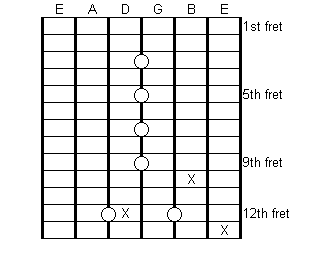

Well, where can I start? The major scale is the foundation for probably 99% of all the music we listen to. Hopefully now you can create any major scale of your choice and then harmonise it into its basic triads. This enables you to do practically anything ... I'll give a few pointers in this lesson, and maybe also some food for thought so you can get your thinking caps on and try some other stuff for yourself.
A little look at blues, The Beatles, Oasis, and Status Quo
Not to try and dis any of the above mentioned artists, but a lot of their material (and all of Status Quo's !) is based on what we learned at the end of Lesson 3. If you recall there are three major chords built up from the notes in any major scale - those built on the root (1st) fourth and fifth degrees. In our long standing example of the key of C this would be the chords of C major, F major and G major respectively. Chords are generally written as roman numerals, in CAPITALS for MAJOR chords and in lower case for minor chords, so we have I IV and V for the major chords and ii iii and vi for the minor chords. Chord vii is different so we'll just ignore it - for now!
OK ... try these chords on your guitar - just play them with one downstroke of the pick for each beat of the bar.
Bar 1 - C
Bar 2 - F
Bar 3 - G
Bar 4 - C
This should sound familiar, and in fact it is. As I said most of the artists listed above have used this formula for a lot of their songs, and it isn't without reason. The fact that these are the only major chords you can get from a chosen major scale means that they are very powerful. No two keys (ie scales) could possibly have the same three major chords, so to play each of the three chords determines without any doubt whatsoever which key you're playing in and defines its sound and tonality better than any other chords could. At the risk of offending all blues fans all over the world I'd like to say that a lot of the basic bar blues is based around these three chords. There are major blues and minor blues, and so on, but all revolve around this I IV V pattern ... look :-
Bar 1 - C
Bar 2 - C
Bar 3 - F
Bar 4 - C
Bar 5 - G half bar, then F half bar
Bar 6 - C half bar, then G half bar
etc etc etc
Hopefully you can get the idea that these chords are important. I could give loads of examples of songs using these chords, but I'm not going to! If you can get the sound and feel of the change from one chord to the next you can try and spot it while you're listening to music. If you're right in your guess, and you can find what chord is the I chord, then not only can you say what the other chords are but you also say which key the song's in!
OK ... now for a little more theory (yawn!!!). I think it is a very worthwhile exercise to make up your own chords. You should have a chart of all the notes all over the neck. If not I've done one which can be found here. Remember to hit your browser's back button to get back here. Now you know how to create your own triads, you can make up your own chords. It's really easy - all you do is play as many of the three notes in the triad as you like and you'll still be playing that chord. It does help, though, to double only the root if at all possible, and then maybe the 5th as well, but it's really up to you. As an example I'm going to list a fingering of the ii iii and vi chords in C major, and for each chord I'm going to use what I would consider to be a "non-standard" fingering.
D minor - notes contained are D F and A

E minor - notes contained are E G & B

A minor - notes contained are A C & E
